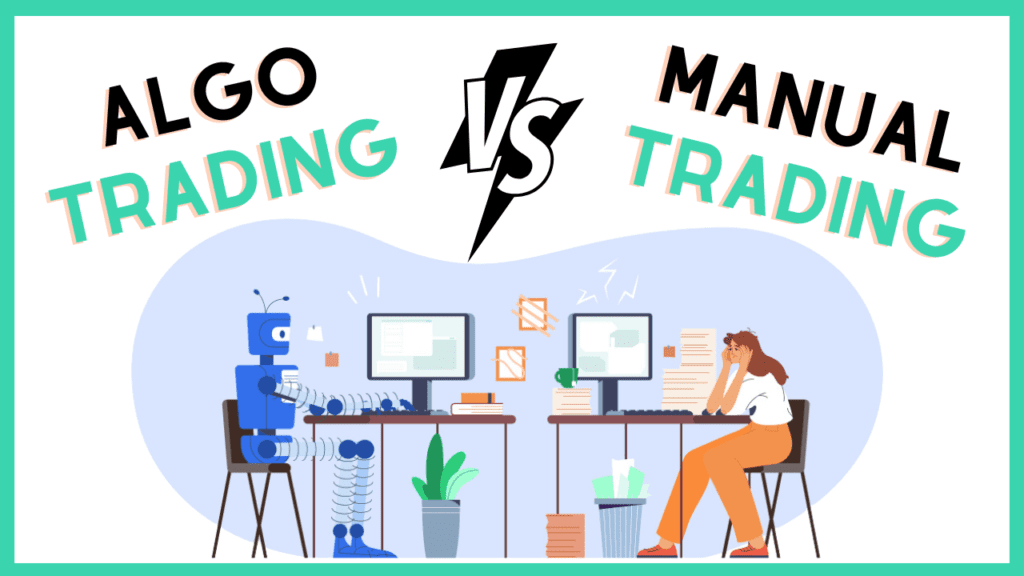Demystifying Algo vs. Manual Trading: Finding Your Path to Financial Success

In the ever-evolving landscape of financial markets, two distinct approaches to trading have emerged: algorithmic (algo) trading and manual trading. Each method offers its own set of advantages and challenges, leaving traders to wonder which path will lead to greater financial success. In this blog, we’ll delve into the world of algo trading and manual trading, exploring their differences, benefits, and pitfalls to help you navigate your journey toward profitability.
Understanding Algo Trading :
Algorithmic trading, often referred to as automated trading, involves the use of computer algorithms to execute trades based on predefined criteria and rules. These algorithms analyze vast amounts of market data, historical patterns, and mathematical models to identify profitable opportunities and execute trades at lightning-fast speeds. Algo trading is popular among institutional investors and hedge funds due to its ability to capitalize on market inefficiencies and maintain discipline in executing trading strategies.
Advantages of Algo Trading :
- Speed and Efficiency: Algo trading enables trades to be executed swiftly, eliminating the delays inherent in manual trading and capitalizing on fleeting market opportunities.
- Accuracy and Consistency: Algorithms make trading decisions based on objective criteria and historical data, reducing the influence of human emotions and biases.
- Risk Management: Algo trading allows for precise risk management through the implementation of stop-loss orders, position sizing algorithms, and other risk mitigation strategies.
Challenges of Algo Trading :
- Cost: Developing and maintaining sophisticated algorithms requires substantial financial investment in technology infrastructure, software development, and data analysis.
- Complexity: Designing effective trading algorithms demands expertise in quantitative analysis, programming languages, and financial markets, posing a barrier to entry for individual traders.
- Technical Failures: Despite their precision, algorithms are susceptible to technical glitches, data inaccuracies, and unexpected market conditions, which can result in significant losses if not properly managed.
Exploring Manual Trading :
Manual trading, on the other hand, involves human traders making trading decisions based on personal judgment, market analysis, and intuition. It relies on fundamental and technical analysis, news events, and economic indicators to identify trading opportunities and execute trades manually through trading platforms or brokers.
Advantages of Manual Trading :
- Flexibility: Manual traders have the freedom to adapt their trading strategies in real-time to changing market conditions, news events, and emerging trends.
- Intuition and Experience: Seasoned traders can leverage their experience, market knowledge, and intuition to anticipate market movements and make informed trading decisions.
- Lower Cost: Manual trading requires minimal upfront investment in technology and software, making it accessible to individual traders with limited resources.
Challenges of Manual Trading :
- Time and Effort: Manual trading demands significant time and effort spent on market analysis, trade execution, and monitoring, limiting scalability and diversification.
- Emotional Bias: Human traders are susceptible to emotions such as fear, greed, and overconfidence, which can cloud judgment and lead to impulsive or irrational trading decisions.
- Subjectivity: Manual trading decisions are inherently subjective and prone to cognitive biases, interpretation errors, and inconsistent performance over time.
Finding Your Path to Financial Success :
Ultimately, the choice between algo trading and manual trading depends on your individual preferences, goals, resources, and risk tolerance. If you have access to advanced technology, quantitative expertise, and sufficient capital, algo trading may offer the potential for greater efficiency, accuracy, and scalability. However, if you value flexibility, intuition, and hands-on control over your trades, manual trading may be better suited to your trading style and personality.
Conclusion :
In conclusion, both algo trading and manual trading have their merits and limitations, and there is no one-size-fits-all approach to trading success. By understanding the differences between these two methods, assessing your strengths and weaknesses as a trader, and aligning your trading strategy with your financial goals, you can embark on a path to financial success that suits your unique circumstances and preferences. Whether you choose to embrace the speed and precision of algo trading or the adaptability and intuition of manual trading, remember that success in the financial markets requires discipline, patience, and continuous learning.
